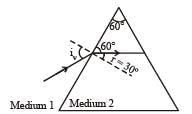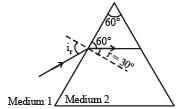JEE Exam > JEE Questions > Two beams of red and violet colours are made ...
Start Learning for Free
Two beams of red and violet colours are made to pass separately through a prism (angle of the prism is 60°). In the position of minimum deviation, the angle of refraction will be
- a)30° for both the colours
- b)greater for the violet colour
- c)greater for the red colour
- d)equal but not 30° for both the colours
Correct answer is option 'A'. Can you explain this answer?
Verified Answer
Two beams of red and violet colours are made to pass separately throug...


For minimum deviation the ray in the prism is parallel to the base of the prism. This condition does not depend on the colour (or wave length) of incident radiation. So in both the cases, by geometry, r = 30º. So (a) is correct option.
Most Upvoted Answer
Two beams of red and violet colours are made to pass separately throug...
Degrees). Which beam will be deviated more?

|
Explore Courses for JEE exam
|

|
Similar JEE Doubts
Two beams of red and violet colours are made to pass separately through a prism (angle of the prism is 60°). In the position of minimum deviation, the angle of refraction will bea)30° for both the coloursb)greater for the violet colourc)greater for the red colourd)equal but not 30° for both the coloursCorrect answer is option 'A'. Can you explain this answer?
Question Description
Two beams of red and violet colours are made to pass separately through a prism (angle of the prism is 60°). In the position of minimum deviation, the angle of refraction will bea)30° for both the coloursb)greater for the violet colourc)greater for the red colourd)equal but not 30° for both the coloursCorrect answer is option 'A'. Can you explain this answer? for JEE 2025 is part of JEE preparation. The Question and answers have been prepared according to the JEE exam syllabus. Information about Two beams of red and violet colours are made to pass separately through a prism (angle of the prism is 60°). In the position of minimum deviation, the angle of refraction will bea)30° for both the coloursb)greater for the violet colourc)greater for the red colourd)equal but not 30° for both the coloursCorrect answer is option 'A'. Can you explain this answer? covers all topics & solutions for JEE 2025 Exam. Find important definitions, questions, meanings, examples, exercises and tests below for Two beams of red and violet colours are made to pass separately through a prism (angle of the prism is 60°). In the position of minimum deviation, the angle of refraction will bea)30° for both the coloursb)greater for the violet colourc)greater for the red colourd)equal but not 30° for both the coloursCorrect answer is option 'A'. Can you explain this answer?.
Two beams of red and violet colours are made to pass separately through a prism (angle of the prism is 60°). In the position of minimum deviation, the angle of refraction will bea)30° for both the coloursb)greater for the violet colourc)greater for the red colourd)equal but not 30° for both the coloursCorrect answer is option 'A'. Can you explain this answer? for JEE 2025 is part of JEE preparation. The Question and answers have been prepared according to the JEE exam syllabus. Information about Two beams of red and violet colours are made to pass separately through a prism (angle of the prism is 60°). In the position of minimum deviation, the angle of refraction will bea)30° for both the coloursb)greater for the violet colourc)greater for the red colourd)equal but not 30° for both the coloursCorrect answer is option 'A'. Can you explain this answer? covers all topics & solutions for JEE 2025 Exam. Find important definitions, questions, meanings, examples, exercises and tests below for Two beams of red and violet colours are made to pass separately through a prism (angle of the prism is 60°). In the position of minimum deviation, the angle of refraction will bea)30° for both the coloursb)greater for the violet colourc)greater for the red colourd)equal but not 30° for both the coloursCorrect answer is option 'A'. Can you explain this answer?.
Solutions for Two beams of red and violet colours are made to pass separately through a prism (angle of the prism is 60°). In the position of minimum deviation, the angle of refraction will bea)30° for both the coloursb)greater for the violet colourc)greater for the red colourd)equal but not 30° for both the coloursCorrect answer is option 'A'. Can you explain this answer? in English & in Hindi are available as part of our courses for JEE.
Download more important topics, notes, lectures and mock test series for JEE Exam by signing up for free.
Here you can find the meaning of Two beams of red and violet colours are made to pass separately through a prism (angle of the prism is 60°). In the position of minimum deviation, the angle of refraction will bea)30° for both the coloursb)greater for the violet colourc)greater for the red colourd)equal but not 30° for both the coloursCorrect answer is option 'A'. Can you explain this answer? defined & explained in the simplest way possible. Besides giving the explanation of
Two beams of red and violet colours are made to pass separately through a prism (angle of the prism is 60°). In the position of minimum deviation, the angle of refraction will bea)30° for both the coloursb)greater for the violet colourc)greater for the red colourd)equal but not 30° for both the coloursCorrect answer is option 'A'. Can you explain this answer?, a detailed solution for Two beams of red and violet colours are made to pass separately through a prism (angle of the prism is 60°). In the position of minimum deviation, the angle of refraction will bea)30° for both the coloursb)greater for the violet colourc)greater for the red colourd)equal but not 30° for both the coloursCorrect answer is option 'A'. Can you explain this answer? has been provided alongside types of Two beams of red and violet colours are made to pass separately through a prism (angle of the prism is 60°). In the position of minimum deviation, the angle of refraction will bea)30° for both the coloursb)greater for the violet colourc)greater for the red colourd)equal but not 30° for both the coloursCorrect answer is option 'A'. Can you explain this answer? theory, EduRev gives you an
ample number of questions to practice Two beams of red and violet colours are made to pass separately through a prism (angle of the prism is 60°). In the position of minimum deviation, the angle of refraction will bea)30° for both the coloursb)greater for the violet colourc)greater for the red colourd)equal but not 30° for both the coloursCorrect answer is option 'A'. Can you explain this answer? tests, examples and also practice JEE tests.

|
Explore Courses for JEE exam
|

|
Signup for Free!
Signup to see your scores go up within 7 days! Learn & Practice with 1000+ FREE Notes, Videos & Tests.


























